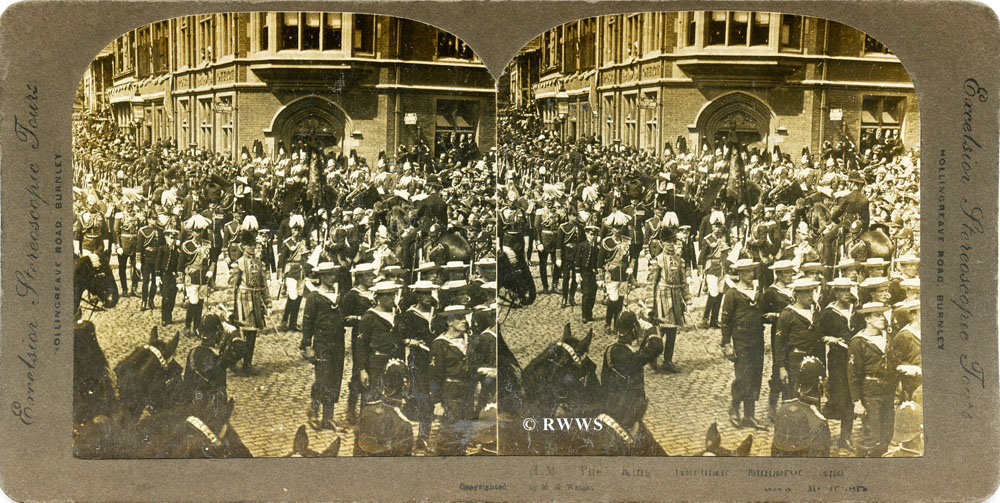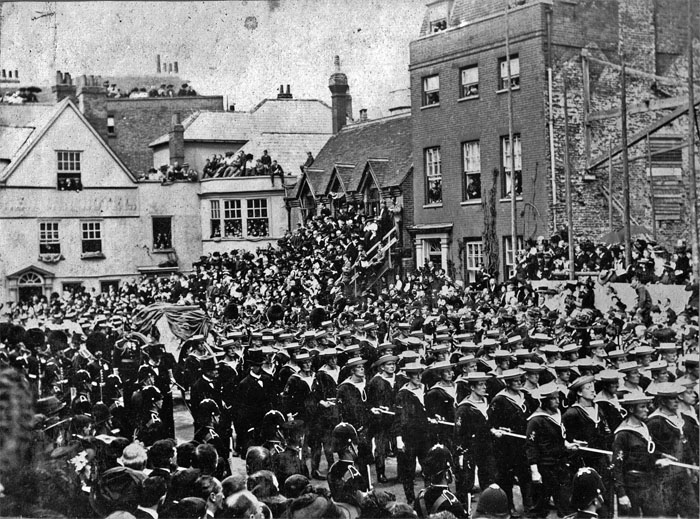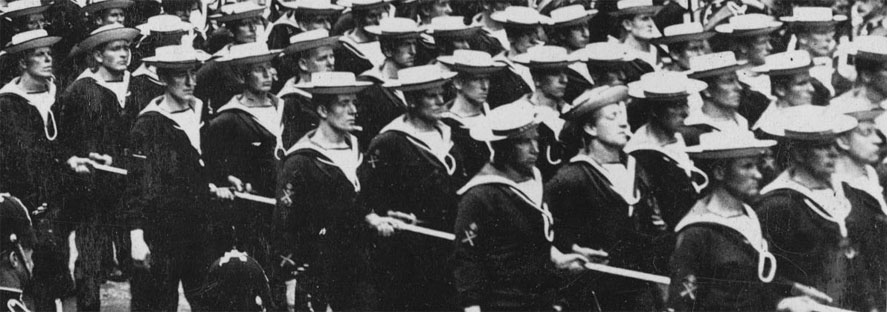
Mourners following
the king's funeral cortege.
 The Funeral Train
passes through Ealing with crowds lining the trackside.
The Funeral Train
passes through Ealing with crowds lining the trackside.
Apparently, on the return journey from
Windsor to Paddington, the train used the 'slow' line as a result
of a mishap to an engine at Slough while the Funeral train was
at Windsor. A postcard, reproduced below, was published by E
Pouteau, 231a, Grays Inn Road, W.C. of the train returning to
London.

The Royal Train pictured here on
the Windsor to Slough line on the 'wrong' tracks because of an
incident at Slough. The train was returning to London, Paddington
after bringing the coffin of Edward VII and mourners to Windsor.

Another image of the Royal Train
on the Windsor branch line.

The courtège
emerges from Windsor's Central Station

Passing Barclays
Bank at the junction with Peascod Street, pulled by naval ratings,
the 'Blue Coats'

The nine monarchs and the Duke
of Cornwall passing The Guildhall
 The courtège
has just passed the Guildhall, top, and is coming to the Parish
Church
The courtège
has just passed the Guildhall, top, and is coming to the Parish
Church

On horseback are
King George V, with The German Emperor, to the king's right,
with The Duke of Connaught to the right of the picture
 The Funeral Procession
passes down the hill in Lower Ward
The Funeral Procession
passes down the hill in Lower Ward

The Funeral Procession
turns towards The Horseshoe Cloisters

The Funeral Procession
passes from the Lower Ward into the Horseshoe Cloisters with
the steps of St George's Chapel beyond.
Note the floral
tributes (top R) on the grass displayed for the public to view
and a top hat removed and placed on the ground (bottom L of centre)
as the cortege passes.

The king's coffin
arrives at the steps of St George's Chapel
 Entering St George's
Chapel
Entering St George's
Chapel
 Flowers on the
lawns outside St George's Chapel
The above postcards
are from our archive of postcards dating from 1910.
Flowers on the
lawns outside St George's Chapel
The above postcards
are from our archive of postcards dating from 1910.
A Personal Reminiscence
of the Funeral
History dated
1929
In addition to King George V there were
8 crowned heads in the procession - the German Emperor, the Kings
of Norway, Greece and Spain, of Bulgaria, Denmark and Portugal,
and the King of the Belgians; in addition to our own Royal Princes,
about 30 others, including the Archduke, Franz Ferdinand of Austria,
were present.
After a long time of waiting, the Royal train arrived
at Windsor, bearing the body of King Edward.
The coffin was placed on the bier, and the wonderful
procession of Royalties started, on foot, through the High Street,
Windsor, to the Long Walk and so up to the Castle and downhill
again to the West door of St. George's Chapel.
When the Royal personages had taken their places
in the Chapel, the silence was broken by the wonderful words
of the Funeral Service until the voice of Garter King of Arms
was raised announcing the death of King Edward VII and the accession
of King George V.
No one who actually saw or took part in the proceedings
of 20th May 1910 is ever likely to forget them,
So it was over, those few short years of the reign
of King Edward VII, who now lay in the Tomb House under St. George's
Chapel, waiting for the day in which he would be joined by his
gracious Consort, Queen Alexandra.
There seemed to be a great void in the world. The
concourse of Royalty at the funeral testified to the peculiar
position of King Edward as, to quote a foreign jest, the 'Uncle
of Europe'.
This gathering was, nevertheless, more than a mere
family gathering, it was the mustering of a profession. King
Edward himself had said that "his profession was to be a
King and for this profession he had trained himself throughout
his life".
Those who followed him to the grave were either trained
for the same calling, or in training - learning their business.
After a lapse of nearly 20 years, the onlooker and
historian can form an opinion on this profession, and whether
he would congratulate or condole with any person who had to take
it up.
There follows a list of the names of the Royal personages
who attended the funeral of King Edward VII and their fates in
the following years.
- William II, German Emperor - a lonely,
discredited exile in Holland, and George, King of the Hellenes
- assassinated at Salonica.
- Manoel II, King of Portugal - driven from
his throne and exiled in England during the revolution of 5th
October 1910.
- Ferdinand, King of Bulgaria - abdicated.
- Albert, King of the Belgians - driven
from all but a corner of his country during four years of war.
- Alfonso, King of Spain XIII an exile from
his country. (1931)
- Archduke Franz Ferdinand of' Austria -
assassinated at Sarajevo, June, 1914.
- Constantine, Duke of Sparta, afterwards
King of the Hellenes twice deposed and died prematurely.
- Prince Michael Alexandrovitch of Russia
- murdered by the Bolsheviks, 1917.
A 'behind the scenes'
story!
|
We have received the following email from
Hugh McCaffrey in Ontario, Canada. January 2003
My father was one of the
Grenadier Guardsmen who carried King Edward VII's coffin at his
funeral. Are there any photographs available good enough to recognize
people? All I know is that he was the second Guardsman from the
front, but I do not know which side of the coffin. Any leads
or links would be welcome.
There must be many stories connected with a funeral
of this magnitude. This is one.
All troops were up at the
crack of dawn as usual. All but one pall bearer had breakfast,
he was busy getting his ceremonial uniform up to inspection standard.
Dressed for the big day, he tried to get some food after the
mess hall had closed from the cookhouse. A cook who was holding
a pan of fat, threw it at him covering a big portion of his uniform.
My father told my sister that there was a big panic to get a
uniform replacement. So one pall bearer at that funeral was not
a happy bunny!
We have received the following email from
Jim Dolan in Ireland. May 2003.
My great uncle was the
standard bearer at this funeral. He was an officer in
the Guards. His name I am pretty sure was Herbert Lyons from
Croom in
Co.Limerick
Jim Dolan
|

We are grateful to Richard Weeks for sending
the above picture of Edward VII's funeral cortège in which
his grandfather, Sergeant William Weeks, appears centre left,
marked by a cross by his feet. Richard has also supplied the
following photographs of Edward VII when Prince of Wales and
his Queen Consort, Alexandra.
|

King Edward VII as Prince of Wales
|
 Queen Alexandra
Queen Alexandra
|
November 2006. Martin Reed
writes:
Troop Serjeant Major John Roughan Yeoman
of the Guard 9th Lancers was on duty at Queen Victoria's Lying-in-State
and also Edward VII's Lying-in-State and George V's Coronation.
Picture and more information here The
Funeral Processions of Queen Victoria
See also
Any
information or additional material about Windsor is always welcomed
and acknowledged.
Copies of photographs or texts
can be emailed to the Editor,
The Royal Windsor Web Site
 To contact us,
email Thamesweb.
To contact us,
email Thamesweb.
|





















